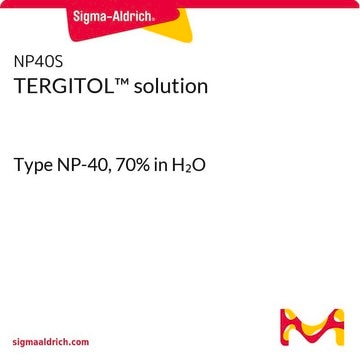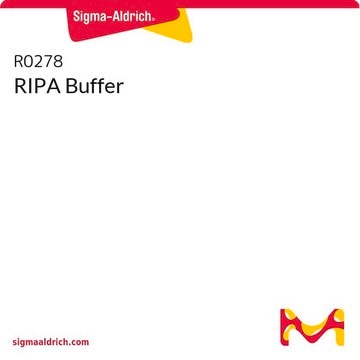If this product has an expiration or retest date, it will be shown on the Certificate of Analysis (COA, CofA). If there is no retest or expiration date listed on the product's COA, we do not have suitable stability data to determine a shelf life. For these products, the only date on the COA will be the release date; a retest, expiration, or use-by-date will not be displayed.
For all products, we recommend handling per defined conditions as printed in our product literature and website product descriptions. We recommend that products should be routinely inspected by customers to ensure they perform as expected.
For products without retest or expiration dates, our standard warranty of 1 year from the date of shipment is applicable.
For more information, please refer to the Product Dating Information document: https://www.sigmaaldrich.com/deepweb/assets/sigmaaldrich/marketing/global/documents/449/386/product-dating-information-mk.pdf
推荐产品
等级
Molecular Biology
for molecular biology
描述
non-ionic
表单
liquid
技术
IR spectroscopy: suitable
CMC
0.08 mM (20-25°C)
HLB
13
异质活性
DNase and RNase, none detected
SMILES字符串
O(CCO)c1ccc(cc1)C(CC(C)(C)C)(C)C
InChI
1S/C16H26O2/c1-15(2,3)12-16(4,5)13-6-8-14(9-7-13)18-11-10-17/h6-9,17H,10-12H2,1-5H3
InChI key
JYCQQPHGFMYQCF-UHFFFAOYSA-N
正在寻找类似产品? 访问 产品对比指南
一般描述
应用
其他说明
质量
注意
法律信息
警示用语:
Danger
危险分类
Acute Tox. 4 Oral - Aquatic Acute 1 - Aquatic Chronic 1 - Eye Dam. 1 - Skin Irrit. 2
储存分类代码
10 - Combustible liquids
WGK
WGK 2
闪点(°F)
483.8 °F - closed cup
闪点(°C)
251 °C - closed cup
个人防护装备
Eyeshields, Gloves, type ABEK (EN14387) respirator filter
其他客户在看
实验方案
使用RIP试剂盒进行哺乳动物细胞Ago抗体-RNA免疫沉淀的实验方案和流程
Procedure and protocol for Anti Ago-RNA Immunoprecipitation from mammalian cells using the RIP kit
This page provides information about different pull-down assays for the further isolation of multiprotein complexes to identify their components with products from Cytiva.
相关内容
利用亲和力、GST pull-down、TAP 和共免疫沉淀方法,通过Pull-Down研究体外蛋白质互作。
Investigate in vitro protein-protein interactions with pull-down assays, utilizing affinity, GST pull-down, TAP, and co-immunoprecipitation methods.
Investigate in vitro protein-protein interactions with pull-down assays, utilizing affinity, GST pull-down, TAP, and co-immunoprecipitation methods.
Investigate in vitro protein-protein interactions with pull-down assays, utilizing affinity, GST pull-down, TAP, and co-immunoprecipitation methods.
-
How can I determine the shelf life / expiration / retest date of this product?
1 answer-
Helpful?
-
-
How is shipping temperature determined? And how is it related to the product storage temperature?
1 answer-
Products may be shipped at a different temperature than the recommended long-term storage temperature. If the product quality is sensitive to short-term exposure to conditions other than the recommended long-term storage, it will be shipped on wet or dry-ice. If the product quality is NOT affected by short-term exposure to conditions other than the recommended long-term storage, it will be shipped at ambient temperature. As shipping routes are configured for minimum transit times, shipping at ambient temperature helps control shipping costs for our customers. For more information, please refer to the Storage and Transport Conditions document: https://www.sigmaaldrich.com/deepweb/assets/sigmaaldrich/marketing/global/documents/316/622/storage-transport-conditions-mk.pdf
Helpful?
-
-
In which solvent(s) is Atazanavir Sulfate soluble?
1 answer-
Atazanavir Sulfate is soluble in DMSO: 104mg/mL and EtOH: 20mg/mL.
Helpful?
-
-
What is the storage temperature for this item?
1 answer-
This product may be stored at room temperature. For products with no specified storage temperature given on the label or product page, ambient storage may be assumed. Products that require controlled temperature storage, such as refrigeration or freezer conditions, storage temperatures are published on the product label, Certificate of Analysis, the Safety Data Sheet (SDS).
Helpful?
-
-
Hi, I am enquiring about the storage temperature of product IGEPAL(R) CA-630 (I8896-100ml). The storage class is listed in the SDS but no temperature upper and lower limits. Would I be able to request this information. Thank you
1 answer-
This product may be stored at room temperature. For products with no specified storage temperature given on the label or product page, ambient storage may be assumed. Products that require controlled temperature storage, such as refrigeration or freezer conditions, storage temperatures are published on the product label, Certificate of Analysis, and the Safety Data Sheet (SDS).
Helpful?
-
-
What is the molecular weight of Product No. I8896, IGEPAL® CA-630?
1 answer-
The approximate molecular weight of this product is 603 Daltons. The average EO (ethylene oxide) units per molecule are 9.
Helpful?
-
-
What is the wt/vol % of this IGEPAL reagent? I want to use it for ATAC-seq and in the protocols people always mention the concentration of the stock is 10% wt/vol but I can't find this information on the specifications of this product. Thanks
1 answer-
This product is provided as a neat liquid with a concentration of 100% which can be further diluted. The density of IGEPAL CA-630 is 1.06 g/cm3 at 25 °C. For a 10% wt./vol. solution 9.43 mL IGEPAL is needed per 100 mL of solution.
The product is generally stable based on the chemical composition and a 10% (w/v) aqueous solution may be stable refrigerated for at least one month. However, it is important to minimize the exposure of the solution to oxygen (keep closed soon after use). The product does have a tendency to oxidize in air forming peroxides through a free radical process. In addition, some bacterial growth may occur which is evidenced by an odor or formation of a precipitate. Preservatives added to the solution may prevent bacterial growth. Please view the data sheet below: https://www.braskem.com.br/Portal/Principal/Arquivos/html/boletm_tecnico/PP%20Chemical%20Resistance.pdf
Helpful?
-
-
I am looking for Nonidet 40, but I am unable to find it. Do you sell this product? If not, can you suggest a suitable alternate product?
1 answer-
Nonidet 40 or NP40 is no longer commercially available. The Igepal CA-630 (Product No. I8896), is the best substitute product that we can recommend.
Helpful?
-
-
Are the 2 products, Igepal CA-630 (Product No. I8896) and Nonidet 40 the same? How do you use this product?
1 answer-
Igepal CA-630 is chemically indistinguishable to NP40. This non-denaturing detergent is used the same way as that of NP40.
Helpful?
-
-
What does "Molecular Biology Grade" mean?
1 answer-
Molecular Biology Grade means that this product must meet the DNase, RNase, and Nickase specification on the Certificate of Analysis for each lot of the product.
Helpful?
-
Active Filters
我们的科学家团队拥有各种研究领域经验,包括生命科学、材料科学、化学合成、色谱、分析及许多其他领域.
联系技术服务部门










